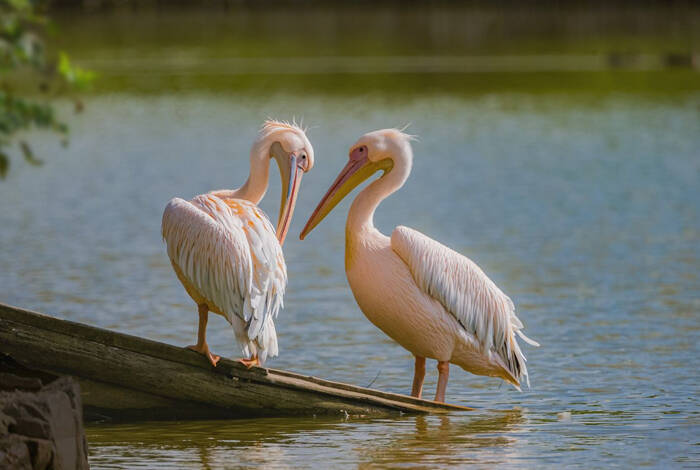Pelecanus onocrotalus
IUCN
LCBasic Information
Scientific classification
- name:Pelecanus onocrotalus
- Scientific Name:Pelecanus onocrotalus,Eastern White Pelican,pelican, troll, gannet, pelican
- Outline:Waterfowl
- Family:pelican g.pelican
Vital signs
- length:140-175cm
- Weight:4-5kg
- lifetime:20-30years
Feature
The beak is long, thick, straight, lead blue, with an orange-yellow sac under the beak.
Distribution and Habitat
The white pelican is found in southern Europe, most African countries, central and southern Asia, etc.; occasionally in other parts of Europe (western and northern), northwest Africa, Oman and the United Arab Emirates. It is almost extinct in Serbia, Montenegro and Sri Lanka. It is extinct in Hungary.
In China, it is found in Xinjiang (western Tianshan Mountains, western and southern waters of the Junggar Basin, Tarim River Basin), Qinghai Lake.
White pelicans mainly live in lakes, rivers, coastal areas and swamps.
Appearance
The body is short and fat, with a slender neck. The whole body is white. The bill is long, thick and straight, lead blue, with an orange-yellow skin pouch under the bill. There is a cluster of long and narrow white crest feathers at the back of the breeding head. The black eyes are very eye-catching on the pink and yellow face patch. There is a cluster of long yellow lanceolate feathers on the chest. The inner vanes of the primary and secondary flight feathers are dark brown, and the feather shafts are white; the outer vanes of the secondary flight feathers are white, sometimes extending to the inner vanes. The head, neck and long crest feathers are decorated with pink and yellow, sometimes extending to the upper back and shoulders. The bill is lead blue, and the tip of the bill and the upper and lower edges of the bill are red. The feet are flesh-colored. The head, neck, middle back and lower body of the young bird are white, and the head and neck are decorated with russet, and the re
Details
White Pelican is called Eastern White Pelican in foreign language. It is a large waterfowl with no subspecies.

White Pelicans mainly feed on fish. They often live in groups. They are good at flying, swimming, and walking well on the ground. When flying, the head is retracted, the neck is bent into an S shape, and the wings are flapped slowly and powerfully. It can also soar and glide back and forth in the air using rising thermal air currents like an eagle, but it usually does not fly as high as an eagle. When swimming in the water, the neck is often bent into an "Y" shape, and it makes hoarse calls from time to time.
White pelicans nest together in groups. They nest on small islands in the lake, reed shallows by the lake, river banks and swamps. The breeding season is from April to June. They nest in shallow water in the reeds or on the muddy ground by the lake, and also in trees. The nest structure is relatively large, consisting of branches, dead grass and aquatic plants. Each nest lays 2-3 eggs, rarely 4. The eggs are white when they are first laid, and turn yellow-brown after hatching. The size is 80-102 mm × 53-65 mm, with an average of 95 mm × 60 mm.
White Pelicans migrate between wintering grounds and breeding grounds in March-April in spring and September-October in autumn. Listed in China's "National Key Protected Wildlife List" (January 14, 1989) Level 2.
China's Red Data Book of Endangered Animals Level: Undetermined Effective Year: 1996
Listed in the "Red List of Endangered Species of the World Conservation Union" (IUCN) 2018 ver 3.1-Least Concern (LC).
Listed in China's "National Key Protected Wildlife List" (February 5, 2021) Level 1.
Protect wild animals and stop eating game.
Maintaining ecological balance is everyone's responsibility!








